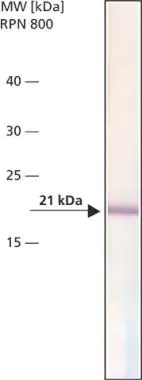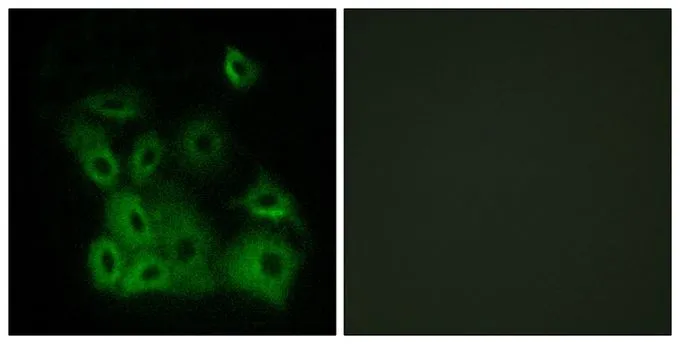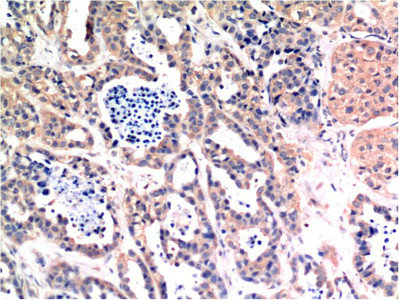![IHC-P analysis of human breast carcinoma tissue using GTX34053 Bax antibody [1C1]. Dilution : 1:200 IHC-P analysis of human breast carcinoma tissue using GTX34053 Bax antibody [1C1]. Dilution : 1:200](https://www.genetex.com/upload/website/prouct_img/normal/GTX34053/GTX34053_20200622_IHC-P_272_w_23060801_135.webp)
IHC-P analysis of human breast carcinoma tissue using GTX34053 Bax antibody [1C1]. Dilution : 1:200
Bax antibody [1C1]
GTX34053
ApplicationsImmunoHistoChemistry, ImmunoHistoChemistry Paraffin
Product group Antibodies
TargetBAX
Overview
- SupplierGeneTex
- Product NameBax antibody [1C1]
- Delivery Days Customer9
- Application Supplier NoteIHC-P: 1:100-1:200. *Optimal dilutions/concentrations should be determined by the researcher.Not tested in other applications.
- ApplicationsImmunoHistoChemistry, ImmunoHistoChemistry Paraffin
- CertificationResearch Use Only
- ClonalityMonoclonal
- Clone ID1C1
- Concentration1 mg/ml
- ConjugateUnconjugated
- Gene ID581
- Target nameBAX
- Target descriptionBCL2 associated X, apoptosis regulator
- Target synonymsBCL2L4, apoptosis regulator BAX, BCL2 associated X protein, BCL2-associated X protein omega, Baxdelta2(G8)-RFS protein, Baxdelta2G9, Baxdelta2G9omega, Baxdelta2omega, bcl-2-like protein 4, bcl2-L-4
- HostMouse
- IsotypeIgG1
- Protein IDQ07812
- Protein NameApoptosis regulator BAX
- Scientific DescriptionThe protein encoded by this gene belongs to the BCL2 protein family. BCL2 family members form hetero- or homodimers and act as anti- or pro-apoptotic regulators that are involved in a wide variety of cellular activities. This protein forms a heterodimer with BCL2, and functions as an apoptotic activator. This protein is reported to interact with, and increase the opening of, the mitochondrial voltage-dependent anion channel (VDAC), which leads to the loss in membrane potential and the release of cytochrome c. The expression of this gene is regulated by the tumor suppressor P53 and has been shown to be involved in P53-mediated apoptosis. Multiple alternatively spliced transcript variants, which encode different isoforms, have been reported for this gene. [provided by RefSeq, Jul 2008]
- Storage Instruction-20°C or -80°C,2°C to 8°C
- UNSPSC12352203

![IHC-P analysis of mouse kidney tissue using GTX34053 Bax antibody [1C1]. Dilution : 1:200 IHC-P analysis of mouse kidney tissue using GTX34053 Bax antibody [1C1]. Dilution : 1:200](https://www.genetex.com/upload/website/prouct_img/normal/GTX34053/GTX34053_20200622_IHC-P_389_w_23060801_503.webp)
![IHC-P analysis of rat testis tissue using GTX34053 Bax antibody [1C1]. Dilution : 1:200 IHC-P analysis of rat testis tissue using GTX34053 Bax antibody [1C1]. Dilution : 1:200](https://www.genetex.com/upload/website/prouct_img/normal/GTX34053/GTX34053_20200622_IHC-P_423_w_23060801_111.webp)



![FACS analysis of Jurkat cells using GTX34420 Bax antibody [SPM336]. Blue : Primary antibody Red : Isotype control](https://www.genetex.com/upload/website/prouct_img/normal/GTX34420/GTX34420_20200115_FACS_1473_w_23060801_417.webp)
![FACS analysis of Jurkat cells using GTX34421 Bax antibody [BAX/962]. Blue : Primary antibody Red : Isotype control](https://www.genetex.com/upload/website/prouct_img/normal/GTX34421/GTX34421_20200115_FACS_1477_w_23060801_735.webp)
![FACS analysis of Jurkat cells using GTX34422 Bax antibody [2D2]. Blue : Blank Red : Isotype control Orange : Primary antibody](https://www.genetex.com/upload/website/prouct_img/normal/GTX34422/GTX34422_20200115_FACS_1482_w_23060801_563.webp)
